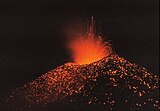Poás Volcano
| Poás Volcano | |
|---|---|
 Poás volcano crater | |
| Highest point | |
| Elevation | 2,708 m (8,885 ft)78 |
| Coordinates | 10°12′N 84°12′W / 10.2°N 84.2°W |
| Geography | |
| Location | Costa Rica |
| Parent range | Cordillera Central |
| Geology | |
| Mountain type | Stratovolcano |
| Last eruption | 2009 to 2014 |
| Climbing | |
| Easiest route | Hike |
The Poás Volcano, (Spanish: Volcán Poás), is an active 2,708-metre (8,885 ft) stratovolcano in central Costa Rica. It has erupted 39 times since 1828.
Crater lakes
There are two crater lakes near the summit. The northern lake is known as the Laguna Caliente ("hot lagoon") and is located at a height of 2,300 m in a crater approximately 1.7 km wide and 290–300 m deep. It is one of the world's most acidic lakes. The acidity varies after rain and changes in volcanic activity, sometimes reaching a pH of almost 0; consequently, it supports little or no aquatic life. The bottom of this lake is covered with a layer of liquid sulphur.[1] Acid gases create acid rain and acid fog, causing damage to surrounding ecosystems and often irritation of eyes and lungs.
Lake Botos, the southern lake, fills an inactive crater, which last erupted in 7500 BC. It is cold and clear, and is surrounded by a cloud forest located within the Poás Volcano National Park.
Eruptive history

Poás was near the epicenter of a 6.1-magnitude earthquake in January 2009 that killed at least forty people and affected Fraijanes, Vara Blanca, Cinchona (the most affected area), the capital San José, and the Central Valley region of Costa Rica.
There was also eruptive activity in 2009 involving minor phreatic eruptions and landslides within the northern active crater. Poás eruptions often include geyser-like ejections of crater-lake water.
On February 25, 2014, a webcam from the Volcanological and Seismological Observatory of Costa Rica (OVSICORI) captured the moment a dark cloud exploded about 1,000 feet in the air from a massive crater of the Poás Volcano. This volcano remains active today.[1] [2] [3]
Pictures
-
Lake Botos is an inactive crater within Poás Volcano National Park
-
Fumarole activity at the Poás crater
See also
References
- ^ O.Vaselli, F.Tassi, A.Minissale, G.Montegrossi, E.Duarte, E.Fernandez, E.Bergamaschi (2003), Fumarole migration and fluid geochemistry at Poás Volcano (Costa Rica), The Geological Society of London.
{{citation}}: CS1 maint: multiple names: authors list (link)
External links



